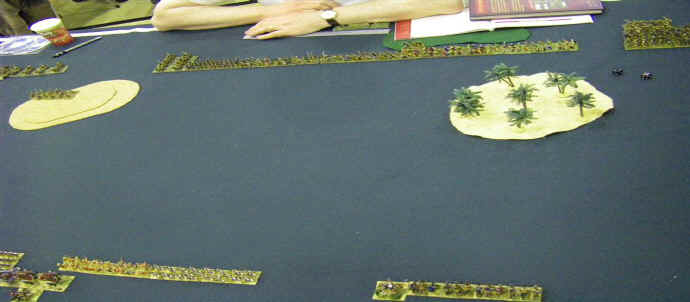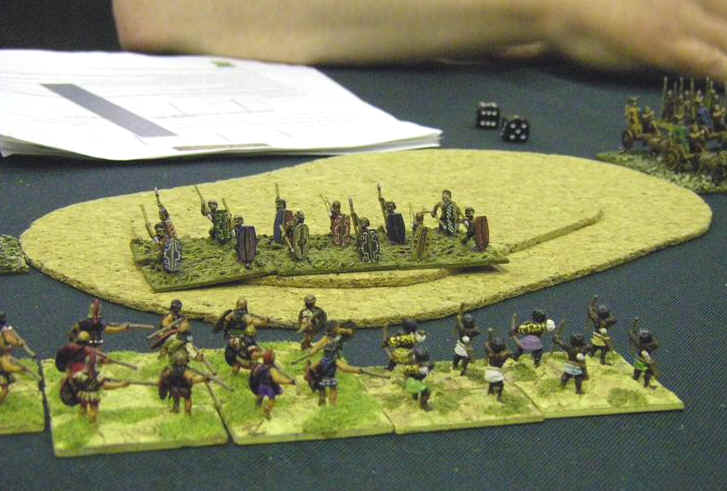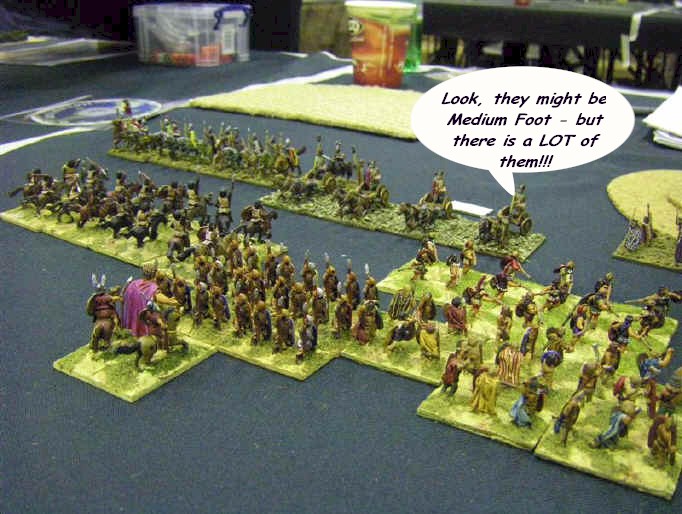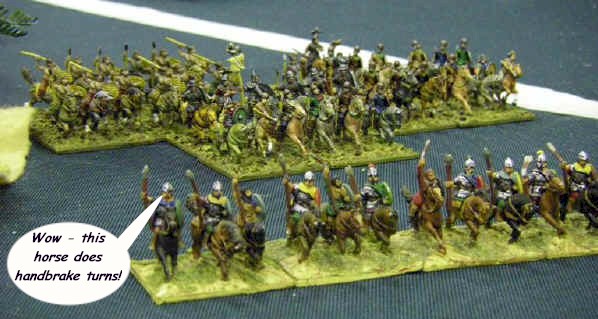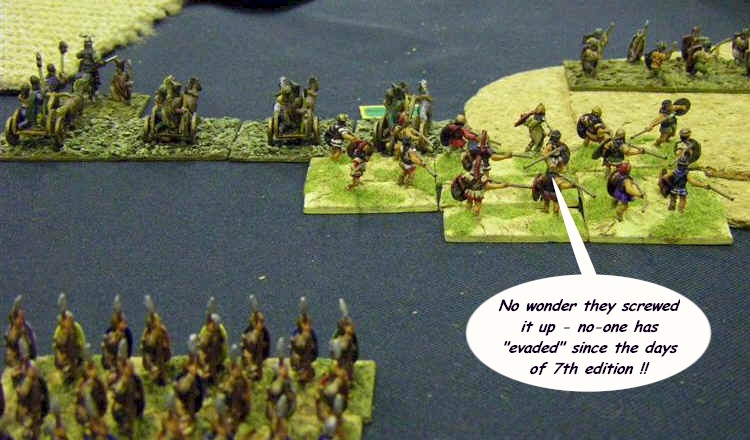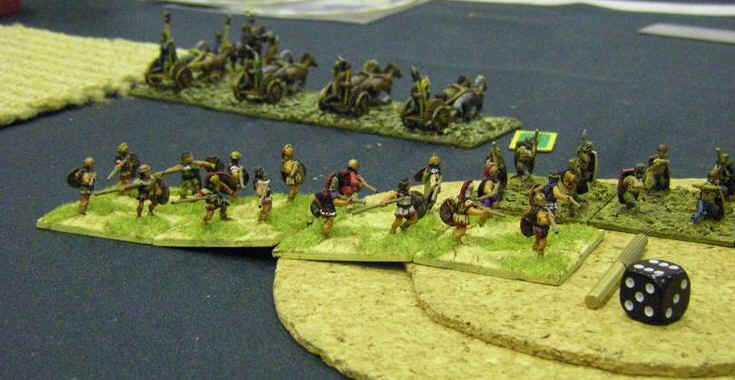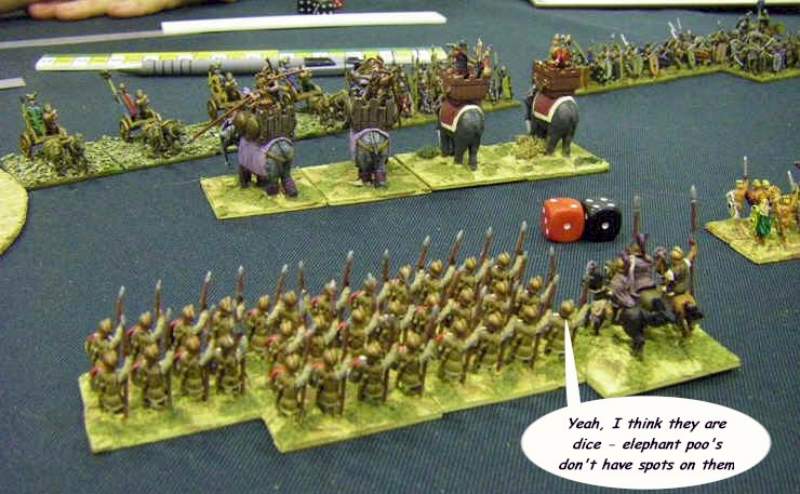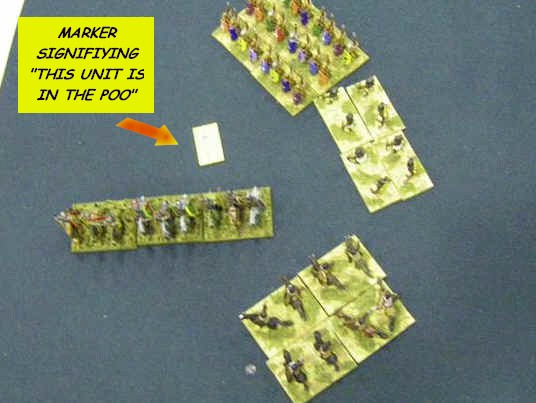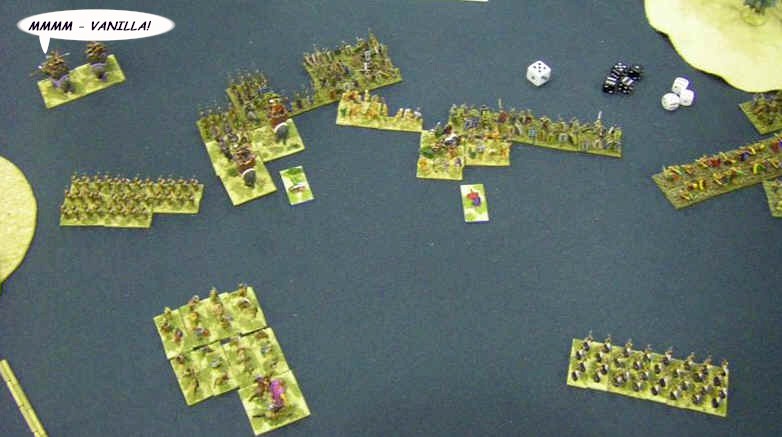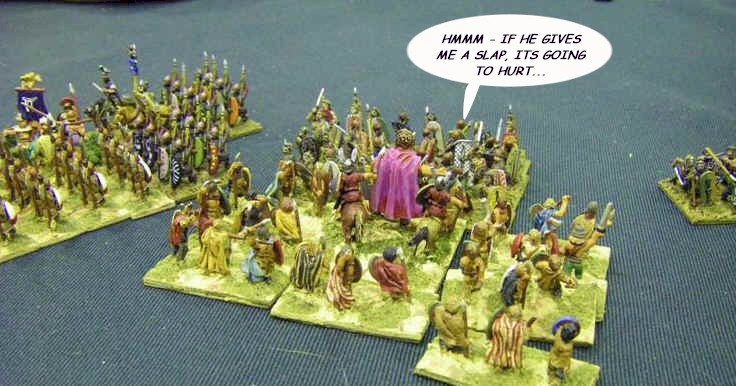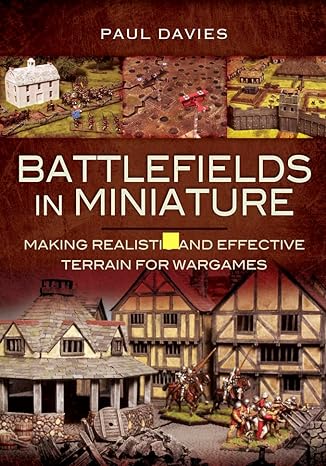Ascot FoG Game 5 - vs Gallic
On the blue, blue grass of Gaul, the Carthaginians faced their last test - another historical matchup against the Gauls
The Gallic army was as listed here and contained a rather messy mix of MF and HF and a surprisingly large amount of cavalry (which had always been rubbish in previous rulesets, so was a surprise to see here today)
One thing the Gauls definately lacked was a serious amount of skirmishers, and my Spaniards and North Africans powered forward to try and sweep they limited skirmish screen off a hill, and so to take a commanding position on the flank of the main lines of the tribesmen. Quite what they were going to do after that was a mystery, but it seemed a good idea at the time. Oh - actually it was to clear the way for all my medium foot to sweep in there too...
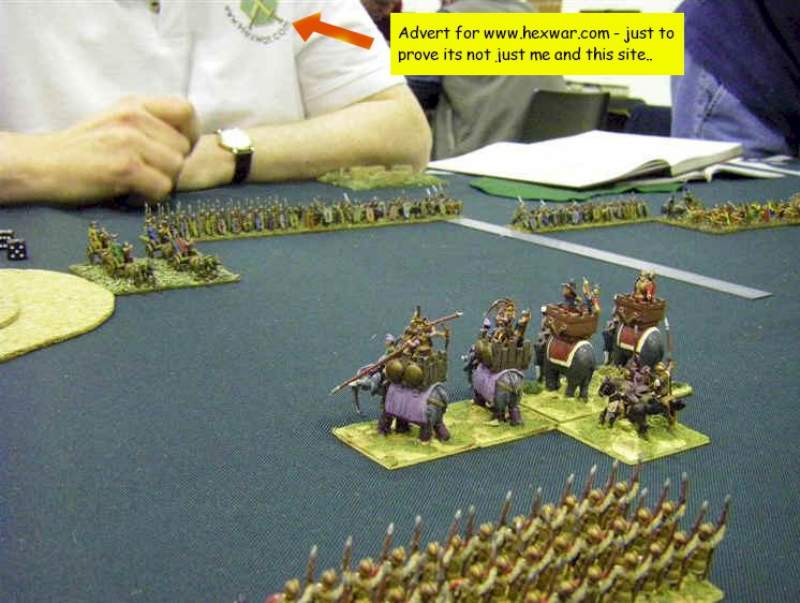
Suspecting the spearmen would not be so competent, Hannibals lieutenant threw forwards his elephants to try and bottle up the Gallic light chariots
The big man himself meanwhile was busy commanding almost everything in the army in one huge blob. The armoured medium foot javelinmen were rather nervous, as were the Numidians in the face of potentially superior enemy forces.
And over on the left our own Gauls had already done the "just in time turn 180 degrees" move so they could spend the next few turns running away from a vastly superior force of Gallic cavalry in that IGOUGO (and we both move the same distance) style.
Flipping back to the left again, my massed forces had scared off the gallic light chariots with a concerted salvo of javelins and an even more concerted charge by almost everything I had - but a burst of speed allowed my light infantry to catch their evade - which foolishly they elected to so!
This caused the disgruntled chariots to suffer a drop to a green and yellow square level of cohesion, and make their exit - allowing my Spanish caetrati to catch the gallic skirmishers in their pursuit!
Cheered considerably by this, the Numidians took the opportunity to remind the remaining Gallic cavalry unit that it was surrounded, and they were allowed to shoot!
The elephants had continued their charge forward - and the Gallic line was quaking. Well, if elite armoured impact foot swordsmen can ever be said to quake...
The pachyderms charged in, and as usual found themselves surprisingly ineffective against troops you'd sort of expect them to skittle out.
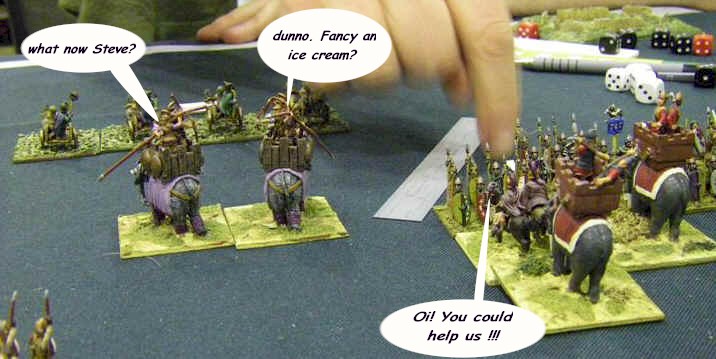
As the chariots fled the elephants pursued aimlessly - they now would never be able to turn around and get back into the battle line to help their colleagues who were struggling manfully against the Soldurii
But things were now looking bad for the Gallic cavalry as the Numidians almost supernatural light-horseesque ability to move away at will allowed the rest of the flanking force the opportunity to help surround them.
The battlefield - and several parts of my army - were by now rather fragmented. The soldurii were still resisting my elephants, the smellies who had broken the light chariots showed no sign of being interested in returning to the field, and various units from both sides were marching frantically to try and either get into combat or to avoid being caught in combat
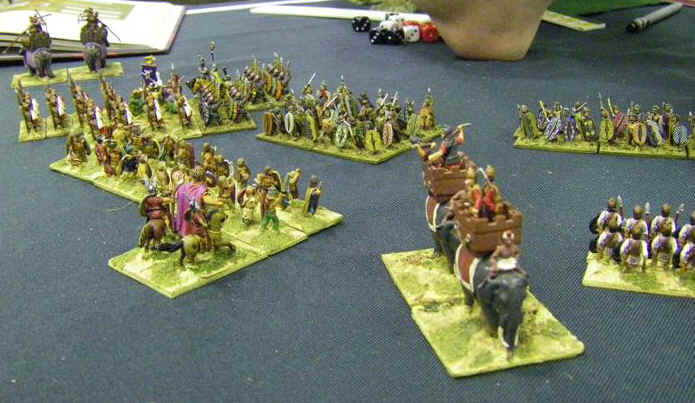
Eventually the soldurii's elite + general status allowed them to break the Carthaginian elephants, who decided to flee the field just as determinedly as their colleagues were refusing to return to it. By now some additional units had actually managed to get close to the enemy and charge in, and the Soldurii were now, with 1/3 casualties, turning to fight off a unit of spearmen.
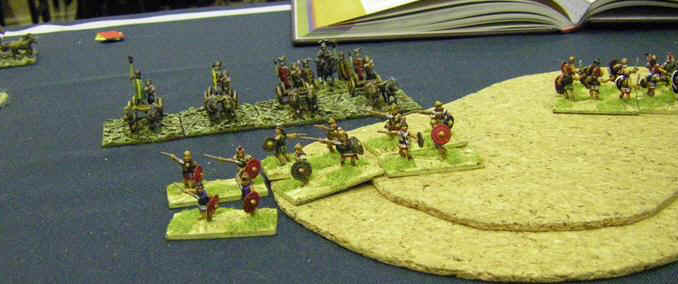
But over on my left it was payback time, as the light chariots, having been rescued by a general before leaving the table, came back to punish my light infantry !
As the desperation of the last turn approached, even Hannibal himself dived into combat - but to no avail. With time running out and the battlefield too fragmented to allow any local advantage to be followed up by either side time was called. A narrow victory for the Carthaginians.
Post Game Analysis
A slightly unsatisfactory end to the competition, with a game that was too spread out to allow two fairly pedestrian - and crucially undrilled - armies to really take advantage of the times when they each struck important blows against each other, as yet again the undrilled troops were unable or reluctant to turn around and rejoin the line of scrimmage. The Elite soldurii proved why there are very few Elite troops in the lists - especially when led by a general they proved largely unbeatable and unkillable. Towards the end the sound of Benny Hill music could almost be heard as units chased each other around the vast empty spaces of the table as the end game dragged on and IGOUGO meant only the edge of the table arriving before the final whilstle could cause either side to be caught
Post Game Analysis from Hannibal
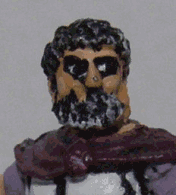
Frankly I'm glad that's all over for another few months. Being associated with you and your crap play is not going to do my pension any good at all. You should know that Elite troops are , well "elite" - the clue is in the name really. Yet again you decided to take on the enemies best troops and failed to hit his weak points - doh!!
At least you won - marginally - this time. Next time however, learn your lesson. Don't take an army with so many average troops, and so many different types. You simply aren't good enough to use them!! Next time I'll play on my own - without your intervention!
The Ancient Army List Index
The Rise of Rome (280 BC to 25 BC) Mid Republican Roman ; Late Republican Roman ; Gallic ; Pyrrhic ; Later Carthaginian ; Ancient Spanish ; Later Macedonian ; Later Seleucid ; Later Ptolemaic ; Attalid Pergamene ; Numidian or early Moorish ; Pontic ; Early Armenian ; Parthian ; Later Jewish ; Illyrian ; Spartacus Slave Revolt ; Bosporan ;
Storm of Arrows - Western Europe in the Later Middle Ages (1300 AD to 1500 AD) Medieval French ; 100-yrs War English (Continental) ; 100-yrs War English (Britain) ; Later Medieval Scots ( Britain) ; Later Medieval Scots (Continental) ; Later Scots Isles & Highlands ; Medieval Welsh ; Later Anglo-Irish ; Medieval Irish ; Low Countries ; Later Medieval German ; Italian Condotta ; Swiss ; Free Company ; Medieval Burgundian ; Medieval Danish ; Medieval Swedish ; Medieval Castilian ; Medieval Crown of Aragon ; Medieval Portugese ; Later Granadine ; Navarrese ; Ordonnance French ; Wars of the Roses English ; Ordonnance Burgundian ; Santa Hermandad Nueva Castilian
Immortal Fire - The Greek, Persian & Macedonian Wars (550 BC - 146 BC)
Classical Greek ;
Early Achaemenid Persian ;
Lydian ;
Thracian ;
Syracusan ;
Early Carthaginian ;
Skythian or Saka ;
Kyrenean Greek ;
Late Dynastic Egyptian ;
Alexandrian Macedonian ;
Later Achaemenid Persian ;
Classical Indian ;
Early Successor ;
Early Sarmatian ;
Galatian ;
Hellenistic Greek ;
Graeco-Bactrian ;
Graeco-Indian ;
Indo-Greek :
Legions Triumphant - Imperial Rome (25 BC to 493 AD) Dominate Roman ; Principate Roman ; Foederate Roman ; Later Sarmatian ; Early German ; Dacian or Carpi ; Ancient British ; Caledonian ; Early Alan ; Jewish Revolt ; Sassanid Persian ; Kushan or Indo-Skythian ; Palmyran ; Early Frankish, Alamanni, Burgundi, Limigantes, Rugian, Suevi or Turcilingi ; Western Hunnic ; Early Visigothic & Early Vandal ; Early Ostrogothic, Herul, Sciri or Taifali ; Early Anglo-Saxon, Bavarian, Frisian, Old Saxon or Thuringian ; Gepid or Early Lombard ; Early Scots Irish ; Early Pictish ; Hephthalite Hunnic ;
Swords & Scimitars - The Crusades (1096 AD to 1311 AD) Early Crusader ; Later Crusader ; Fatimid Egyptian ; Georgian ; Seljuk Turk ; Cuman ; Komnenan Byzantine ; Post Latin Conquest Byzantine ; Ilkhanid Mongol ; Mamluk Egyptian ; Cilician Armenian ; Syrian States ; Khwarazmian ; Ayyubid Egyptian ; Middle Serbian ; Middle Bulgarian ; Medieval Cypriot ; Latin Greece ; Pecheneg ;
Eternal Empire - Eastern Europe and the Rise of the Ottomans (1300 AD to 1500 AD) Early Ottoman Turkish ; Later Ottoman Turkish ; Tatar ; Later Russian ; Later Serbian Empire ; Later Bulgarian ; Later Lithuanian ; Later Polish ; Later Teutonic Knights ; Catalan Company ; Middle Hungarian ; Moldavian or Wallachian ; Albanian ; Timurid, White Sheep Turcoman or Black Sheep Turcoman ; Later Hungarian ; Hussite ;
Decline & Fall - Byzantium and Islam (493 AD to 1071 AD) Early Byzantine; Maurikian Byzantine ; Thematic Byzantine ; Nikephorian Byzantine ; Later Moorish ; Later Visigothic ; African Vandal ; Italian Ostrogothic ; Early South Slav ; Lombard ; Avar ; Arab Conquest ; Early Bulgar ; Ummayad Arab ; Abbasid Arab ; Early North African Dynasties ; Khurasanian Dynasties ; Bedouin Dynasties ; Dailami Dynasties ; Pecheneg ; Ghaznavid ; Western Turkish (includes Khazar);
Wolves From The Sea - The Hairy European Dark Ages Post Roman British ; Early Welsh ; Later Scots Irish ; Merovingian Frankish ; Later Pictish ; Early Slavic ; Middle Anglo Saxon ; Astur Leonese ; Andalusian ; Early Navarrese ; Carolingian Frankish ; Viking ; Magyar ; Great Moravian ; Early Scots ; Rus ; Norse Irish ; Early Medieval French ; Early Medieval German ; Norman ; Early Polish ; Anglo Danish ;
Swifter Than Eagles - The Biblical Book Nubian ; Early Libyan ; Later Sumerian or Akkadian ; Early Nomad Allies ; Old or Middle Kingdom Egyptian ; Hyksos ; Mitanni ; Syro-Canaanite ; New Kingdom Egyptian ; Later Minoan or Early Mycenaean ; Hittite Empire ; ; Middle or Early Neo-Assyrian ; Later Mycenaean or Trojan ; Sea Peoples ; Philistine ; Phoenician Allies ; Neo-Hittite And Aramaean ; Later Hebrew ; Mannaean Allies ; Libyan Egyptian ; Urartian ; Median ; Neo-Elamite ; Proto-Arab Allies ; Cimmerian or Early Skythian ; Neo-Assyrian Empire ; Phrygian Allies ; Kushite Egyptian ; Neo-Babylonian Empire ;
Oaf of Fealty - Early Medieval Europe Feudal Catalan and Early Crown Of Aragon ; Early Hungarian ; Taifa Andalusian ; Feudal Navarrese and Aragonese ; Feudal Castilian Leonese or Portuguese ; Fanatic Berber ; Italo-Norman ; Feudal French ; Imperial German ; Feudal German ; Communal Italian ; Papal Italian ; Early Scots Isles And Highlands ; Feudal Scots ; Early Russian ; Feudal Polish ; Anglo-Norman ; Later Welsh ; Early Lithuanian or Samogitian ; Wendish Prussian or Estonian ; Early Medieval Frisia and Other Free Cantons ; Post-Viking Scandinavian ; Early Plantagenet English ; Later Sicilian ; Early Medieval Irish ; Early Anglo-Irish ; Early Teutonic Knights ; Mongol Invasion ; Early Granadine ; Middle Plantagenet English ;
Empires of The Dragon - China, Korea and Japan Erlitou-Shang Chinese ; Early Northern Barbarian Allies ; Early Zhou Chinese ; Yayoi Japanese ; Early Horse Nomad ; Ko Choson Korean ; Warring States To Western Han Chinese ; Qiang And Di ; Three Kingdoms Korean ; Eastern Han Chinese? ; Three Kingdoms W Jin And S Dynasties Chinese ; Kofun Nara Japanese ; Northern Dynasties Chinese ; Later Hindu North Indian ; Later Hindu South Indian ; Central Asian City States ; Western Wei To Early Tang Chinese ; ; Later Horse Nomad ; Tibetan ; Nepalese Allies ; Parhae Korean ; Late Tang To Five Dynasties Chinese ; Khmer Or Champa ; Thai Allies ; Nanzhao ; Pyu Burmese Allies ; Koryo Korean ; Early Heian Japanese ; Pagan Burmese ; Liao ; Song Chinese ; Xi Xia ; Ghurid Afghan ; Jin ; Late Heian To Muromachi Japanese ; Japanese Warrior Monk Allies ; Mongol Conquest ; Moslem Indian Sultanates ; Medieval Indonesian Or Malay ; Yuan Chinese ; Medieval Burmese ; Ming Chinese ; Yi Korean
Blood and Gold - The Americas Olmec ; Teotihuacan ; West Mexican ; Zapotec or Mixtec ; Toltec ; Chinantec ; Aztec ; Tarascan ; Tlaxcalan Confederacy ; Mayan ; Mochica ; Chanca ; Chimu ; Hatun-Colla ; Canari ; Inca ; Mapuche or Araucanian ; Amazonian Forest Tribes ; Tupi ; Chichimec ; Pueblo Culture ; Mound-Builder Culture ; South-Eastern Woodland Culture ; Timucuan ; Eastern Woodland Culture ; Plains Culture ; Pacific North-West Culture


